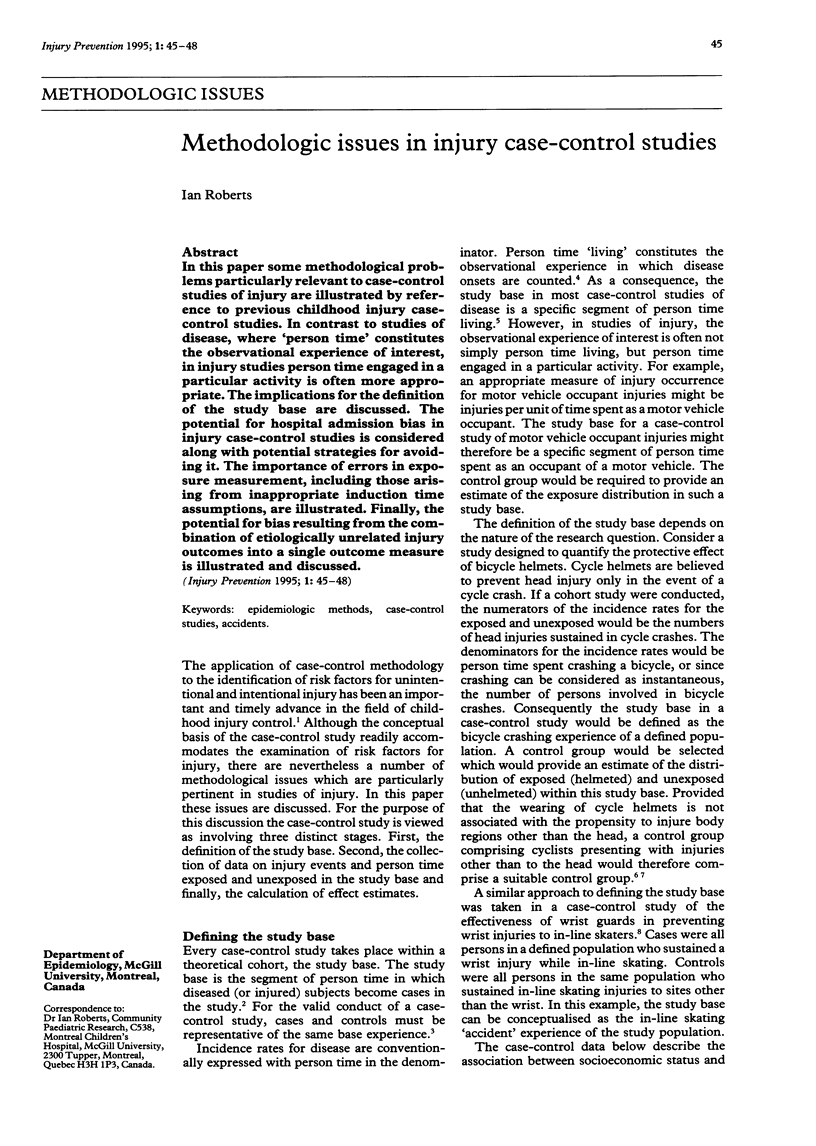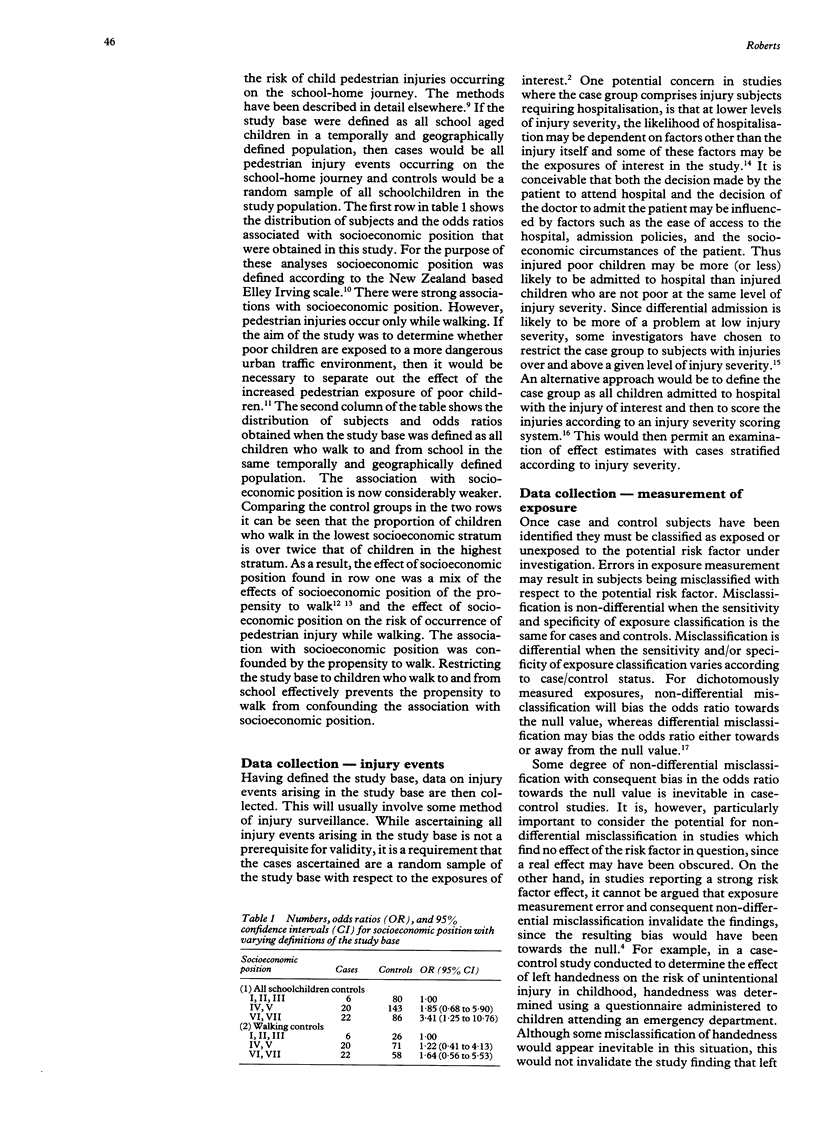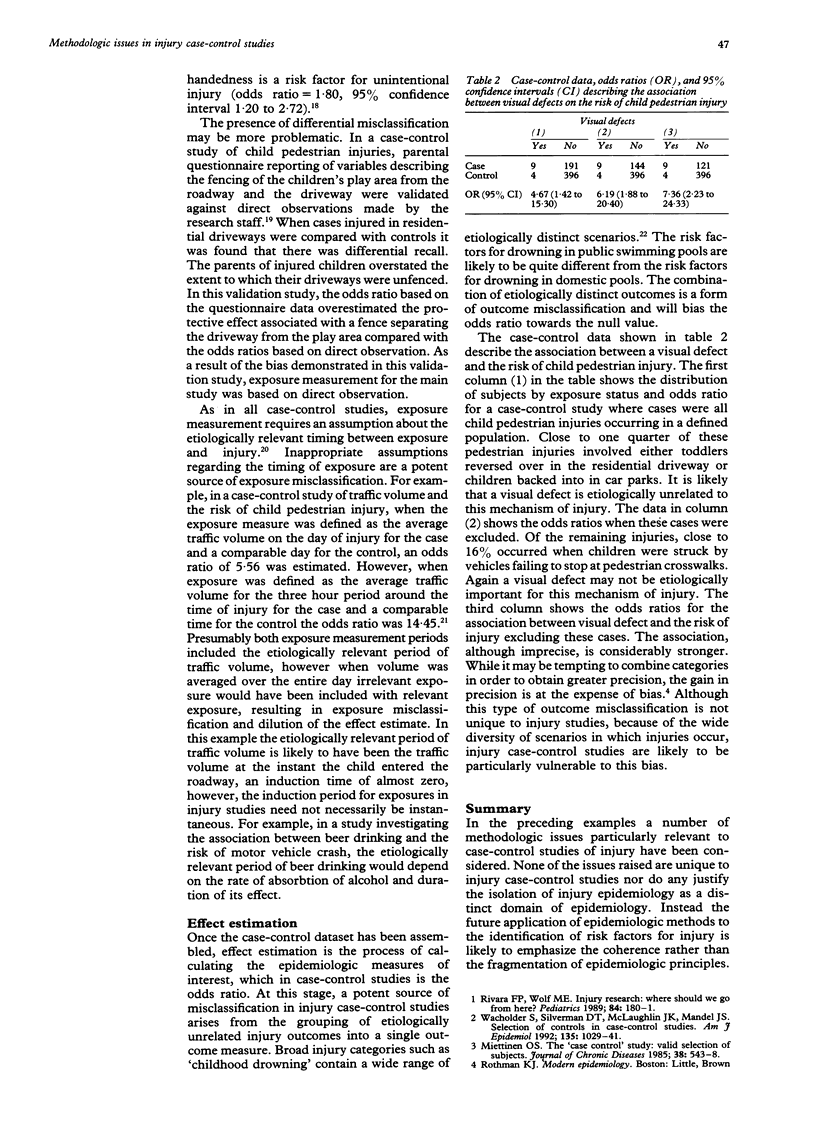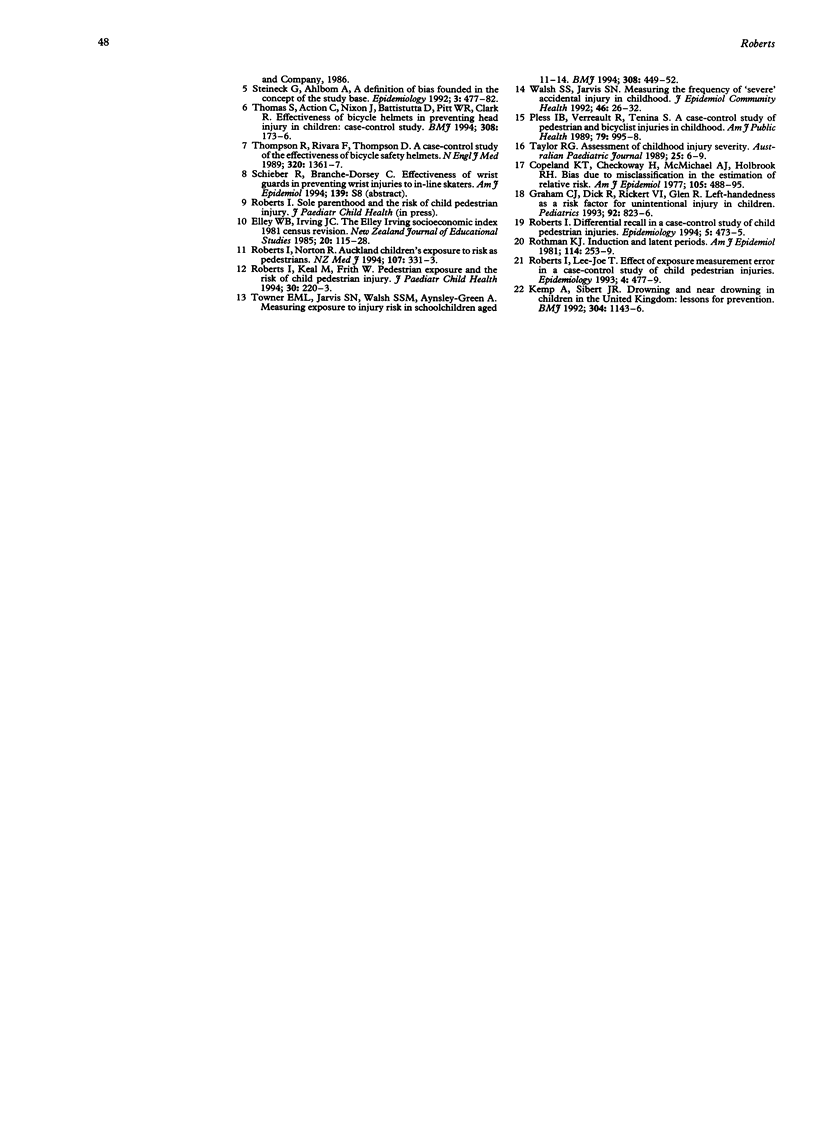Abstract
In this paper some methodological problems particularly relevant to case-control studies of injury are illustrated by reference to previous childhood injury case-control studies. In contrast to studies of disease, where 'person time' constitutes the observational experience of interest, in injury studies person time engaged in a particular activity to often more appropriate. The implications for the definition of the study base are discussed. The potential for hospital admission bias in injury case-control studies is considered along with potential strategies for avoiding it. The importance of errors in exposure measurement, including those arising from inappropriate induction time assumptions, are illustrated. Finally, the potential for bias resulting from the combination of etiologically unrelated injury outcomes into a single outcome measure is illustrated and discussed.
Full text
PDF



Selected References
These references are in PubMed. This may not be the complete list of references from this article.
- Copeland K. T., Checkoway H., McMichael A. J., Holbrook R. H. Bias due to misclassification in the estimation of relative risk. Am J Epidemiol. 1977 May;105(5):488–495. doi: 10.1093/oxfordjournals.aje.a112408. [DOI] [PubMed] [Google Scholar]
- Graham C. J., Dick R., Rickert V. I., Glenn R. Left-handedness as a risk factor for unintentional injury in children. Pediatrics. 1993 Dec;92(6):823–826. [PubMed] [Google Scholar]
- Kemp A., Sibert J. R. Drowning and near drowning in children in the United Kingdom: lessons for prevention. BMJ. 1992 May 2;304(6835):1143–1146. doi: 10.1136/bmj.304.6835.1143. [DOI] [PMC free article] [PubMed] [Google Scholar]
- McMahan S., Ericson J., Meyer J. Depressive symptomatology in women and residential proximity to high-voltage transmission lines. Am J Epidemiol. 1994 Jan 1;139(1):58–63. doi: 10.1093/oxfordjournals.aje.a116935. [DOI] [PubMed] [Google Scholar]
- Miettinen O. S. The "case-control" study: valid selection of subjects. J Chronic Dis. 1985;38(7):543–548. doi: 10.1016/0021-9681(85)90039-6. [DOI] [PubMed] [Google Scholar]
- Pless I. B., Verreault R., Tenina S. A case-control study of pedestrian and bicyclist injuries in childhood. Am J Public Health. 1989 Aug;79(8):995–998. doi: 10.2105/ajph.79.8.995. [DOI] [PMC free article] [PubMed] [Google Scholar]
- Rivara F. P., Wolf M. E. Injury research: where should we go from here? Pediatrics. 1989 Jul;84(1):180–181. [PubMed] [Google Scholar]
- Roberts I. G., Keall M. D., Frith W. J. Pedestrian exposure and the risk of child pedestrian injury. J Paediatr Child Health. 1994 Jun;30(3):220–223. doi: 10.1111/j.1440-1754.1994.tb00622.x. [DOI] [PubMed] [Google Scholar]
- Roberts I. Differential recall in a case-control study of child pedestrian injuries. Epidemiology. 1994 Jul;5(4):473–475. doi: 10.1097/00001648-199407000-00017. [DOI] [PubMed] [Google Scholar]
- Roberts I., Lee-Joe T. Effect of exposure measurement error in a case-control study of child pedestrian injuries. Epidemiology. 1993 Sep;4(5):477–479. doi: 10.1097/00001648-199309000-00015. [DOI] [PubMed] [Google Scholar]
- Roberts I., Norton R. Auckland children's exposure to risk as pedestrians. N Z Med J. 1994 Aug 24;107(984):331–333. [PubMed] [Google Scholar]
- Rothman K. J. Induction and latent periods. Am J Epidemiol. 1981 Aug;114(2):253–259. doi: 10.1093/oxfordjournals.aje.a113189. [DOI] [PubMed] [Google Scholar]
- Steineck G., Ahlbom A. A definition of bias founded on the concept of the study base. Epidemiology. 1992 Nov;3(6):477–482. doi: 10.1097/00001648-199211000-00003. [DOI] [PubMed] [Google Scholar]
- Taylor R. G. Assessment of childhood injury severity. Aust Paediatr J. 1989 Feb;25(1):6–9. doi: 10.1111/j.1440-1754.1989.tb01404.x. [DOI] [PubMed] [Google Scholar]
- Thomas S., Acton C., Nixon J., Battistutta D., Pitt W. R., Clark R. Effectiveness of bicycle helmets in preventing head injury in children: case-control study. BMJ. 1994 Jan 15;308(6922):173–176. doi: 10.1136/bmj.308.6922.173. [DOI] [PMC free article] [PubMed] [Google Scholar]
- Thompson R. S., Rivara F. P., Thompson D. C. A case-control study of the effectiveness of bicycle safety helmets. N Engl J Med. 1989 May 25;320(21):1361–1367. doi: 10.1056/NEJM198905253202101. [DOI] [PubMed] [Google Scholar]
- Towner E. M., Jarvis S. N., Walsh S. S., Aynsley-Green A. Measuring exposure to injury risk in schoolchildren aged 11-14. BMJ. 1994 Feb 12;308(6926):449–452. doi: 10.1136/bmj.308.6926.449. [DOI] [PMC free article] [PubMed] [Google Scholar]
- Wacholder S., Silverman D. T., McLaughlin J. K., Mandel J. S. Selection of controls in case-control studies. II. Types of controls. Am J Epidemiol. 1992 May 1;135(9):1029–1041. doi: 10.1093/oxfordjournals.aje.a116397. [DOI] [PubMed] [Google Scholar]
- Walsh S. S., Jarvis S. N. Measuring the frequency of "severe" accidental injury in childhood. J Epidemiol Community Health. 1992 Feb;46(1):26–32. doi: 10.1136/jech.46.1.26. [DOI] [PMC free article] [PubMed] [Google Scholar]


